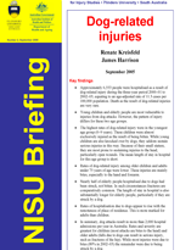Key findings
- Approximately 6,553 people were hospitalised as a result of dog-related injury during the three-year period 2000-01 to 2002-03, equating to an age-adjusted rate of 11.3 cases per 100,000 population. Death as the result of dog-related injuries are very rare.
- Young children and elderly people are most vulnerable to injuries from dog attacks. However, the pattern of injury differs for these two age groups.
- The highest rates of dog-related injury were in the youngest age group (0-9 years). These children were almost exclusively injured as the result of being bitten. While young children are also knocked over by dogs, they seldom sustain serious injuries in this way. Because of their small stature, they are most prone to sustaining injuries to the head, particularly open wounds. The mean length of stay in hospital for this age group is short.
- Rates of dog-related injury among older children and adults under 75 years of age were lower. These injuries are mainly bites, especially to the hand and forearm.
- Nearly half of elderly people hospitalised due to dogs had been struck, not bitten. In such circumstances fractures are comparatively common. The length of stay in hospital is also substantially longer for elderly people, particularly if they are struck by a dog.
- Rates of hospitalisation due to dogs appear to rise with the remoteness of place of residence. This is more marked for adults than children.
- In summary, dog attacks result in more than 2,000 hospital admissions per year in Australia. Rates and severity are greatest for children (most attacks are bites to the head) and older adults (falls due to dogs can result in serious injury, such as fractures of the hip). While most injuries were due to bites (89% in 2002-03) the remainder were due to being struck by a dog.



